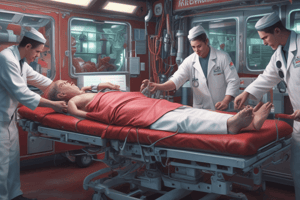Podcast
Questions and Answers
Which factor is NOT directly affected by drugs in relation to hemodynamics?
Which factor is NOT directly affected by drugs in relation to hemodynamics?
- Blood Pressure Regulation (correct)
- Skin Signs
- Respiratory Rate
- Heart Rate
What is the relationship between Cardiac Output and Heart Rate?
What is the relationship between Cardiac Output and Heart Rate?
- Heart Rate has no effect on Cardiac Output
- Cardiac Output is inversely proportional to Heart Rate
- Cardiac Output equals Heart Rate multiplied by Stroke Volume (correct)
- Cardiac Output is dependent only on Stroke Volume
What term best describes the resistance the heart must overcome to eject blood?
What term best describes the resistance the heart must overcome to eject blood?
- Contractility
- Preload
- Stroke Volume
- Afterload (correct)
Which statement about the Electrical System of the Heart is correct?
Which statement about the Electrical System of the Heart is correct?
Which of the following is a typical value range for Central Venous Pressure (CVP)?
Which of the following is a typical value range for Central Venous Pressure (CVP)?
Which treatment is indicated for elevated Afterload?
Which treatment is indicated for elevated Afterload?
What does the Mean Arterial Pressure (MAP) represent in hemodynamics?
What does the Mean Arterial Pressure (MAP) represent in hemodynamics?
Which factor is NOT associated with decreased preload?
Which factor is NOT associated with decreased preload?
What is the normal range for Mean Arterial Pressure (MAP)?
What is the normal range for Mean Arterial Pressure (MAP)?
What is the minimum MAP required to perfuse the kidneys?
What is the minimum MAP required to perfuse the kidneys?
Which factors significantly influence Mean Arterial Pressure (MAP)?
Which factors significantly influence Mean Arterial Pressure (MAP)?
Which formula correctly calculates Mean Arterial Pressure (MAP)?
Which formula correctly calculates Mean Arterial Pressure (MAP)?
How long do the ventricles typically spend in diastole relative to systole?
How long do the ventricles typically spend in diastole relative to systole?
What other pressure is MAP part of the calculation for?
What other pressure is MAP part of the calculation for?
Which condition could potentially indicate a problem with arterial wall compliance?
Which condition could potentially indicate a problem with arterial wall compliance?
In the context of MAP, which of the following medications would be used for low afterload?
In the context of MAP, which of the following medications would be used for low afterload?
What is the equivalent mmHg measurement for an inspiratory pressure of 15 cmH20?
What is the equivalent mmHg measurement for an inspiratory pressure of 15 cmH20?
Which medication class works primarily at the presynaptic receptors to inhibit catecholamine release?
Which medication class works primarily at the presynaptic receptors to inhibit catecholamine release?
What effect do a1-receptors have on the kidneys?
What effect do a1-receptors have on the kidneys?
Which hemodynamic function does the Renin-Angiotensin System (RAS) influence?
Which hemodynamic function does the Renin-Angiotensin System (RAS) influence?
What is the primary effect of Beta-1 receptors in the body?
What is the primary effect of Beta-1 receptors in the body?
Which type of medication is Digoxin classified as?
Which type of medication is Digoxin classified as?
What role do carotid bodies play in hemodynamic compensation?
What role do carotid bodies play in hemodynamic compensation?
What is a common result of the activation of adrenergic receptors in the body?
What is a common result of the activation of adrenergic receptors in the body?
What is the primary goal of treatment aimed at increasing preload?
What is the primary goal of treatment aimed at increasing preload?
Which of the following treatments is recommended for low diastolic pressures?
Which of the following treatments is recommended for low diastolic pressures?
What is indicated if the systolic blood pressure does not change after a fluid challenge?
What is indicated if the systolic blood pressure does not change after a fluid challenge?
Which diuretic is commonly used to treat high diastolic pressures?
Which diuretic is commonly used to treat high diastolic pressures?
What does the term 'contractility' refer to in cardiac physiology?
What does the term 'contractility' refer to in cardiac physiology?
What role do chronotropic drugs play in cardiac function?
What role do chronotropic drugs play in cardiac function?
What is the significance of central venous pressure (CVP) in cardiac assessment?
What is the significance of central venous pressure (CVP) in cardiac assessment?
Which of the following is a potential treatment for rate control in dysrhythmias?
Which of the following is a potential treatment for rate control in dysrhythmias?
What is a primary function of β2-receptors in the lungs?
What is a primary function of β2-receptors in the lungs?
In which tissue are β3-receptors primarily located?
In which tissue are β3-receptors primarily located?
Which treatment utilizes β2 receptor effects for asthma management?
Which treatment utilizes β2 receptor effects for asthma management?
Which of the following interventions would decrease preload according to the hemodynamic overview?
Which of the following interventions would decrease preload according to the hemodynamic overview?
In terms of contractility, which substance is indicated for increasing cardiac contractility?
In terms of contractility, which substance is indicated for increasing cardiac contractility?
Which of the following statements about hemodynamic profiles is accurate?
Which of the following statements about hemodynamic profiles is accurate?
Which physiological role does renin play in the body?
Which physiological role does renin play in the body?
Regarding cardiac electrical activity, which term best signifies the active phase of depolarization?
Regarding cardiac electrical activity, which term best signifies the active phase of depolarization?
What condition is indicated by a Central Venous Pressure (CVP) greater than 12 mmHg?
What condition is indicated by a Central Venous Pressure (CVP) greater than 12 mmHg?
How does systemic vascular resistance (SVR) primarily affect blood pressure?
How does systemic vascular resistance (SVR) primarily affect blood pressure?
What effect does a positive pressure ventilation over 15 cmH20 have on CVP?
What effect does a positive pressure ventilation over 15 cmH20 have on CVP?
In what scenario would you typically observe a low SVR, specifically below 800 mmHg?
In what scenario would you typically observe a low SVR, specifically below 800 mmHg?
Which of the following factors does NOT directly affect hemodynamics?
Which of the following factors does NOT directly affect hemodynamics?
Which term is defined as the amount of blood the heart pumps per minute, taking body size into account?
Which term is defined as the amount of blood the heart pumps per minute, taking body size into account?
What role does afterload primarily play in the cardiovascular system?
What role does afterload primarily play in the cardiovascular system?
Which of the following values represents normal Central Venous Pressure (CVP)?
Which of the following values represents normal Central Venous Pressure (CVP)?
Which factor is crucial for calculating Mean Arterial Pressure (MAP)?
Which factor is crucial for calculating Mean Arterial Pressure (MAP)?
Which class of medication would be used to decrease elevated preload?
Which class of medication would be used to decrease elevated preload?
What does the term 'contractility' primarily refer to in relation to cardiac physiology?
What does the term 'contractility' primarily refer to in relation to cardiac physiology?
What parameter does Stroke Volume represent?
What parameter does Stroke Volume represent?
Which factor could potentially decrease the heart rate during a hemodynamic assessment?
Which factor could potentially decrease the heart rate during a hemodynamic assessment?
What physiological significance does the Mean Arterial Pressure (MAP) have in evaluating blood pressure?
What physiological significance does the Mean Arterial Pressure (MAP) have in evaluating blood pressure?
Which of the following correctly describes the calculation for Mean Arterial Pressure?
Which of the following correctly describes the calculation for Mean Arterial Pressure?
Which value range represents the normal Mean Arterial Pressure (MAP)?
Which value range represents the normal Mean Arterial Pressure (MAP)?
How does the Mean Arterial Pressure (MAP) relate to cerebral perfusion pressure?
How does the Mean Arterial Pressure (MAP) relate to cerebral perfusion pressure?
Which statement accurately describes arterial wall compliance in the context of Mean Arterial Pressure?
Which statement accurately describes arterial wall compliance in the context of Mean Arterial Pressure?
What is the minimum Mean Arterial Pressure (MAP) required to ensure adequate kidney perfusion?
What is the minimum Mean Arterial Pressure (MAP) required to ensure adequate kidney perfusion?
Which factors are considered when determining the clinical significance of MAP?
Which factors are considered when determining the clinical significance of MAP?
Which medications are commonly used to manage high afterload in the context of MAP?
Which medications are commonly used to manage high afterload in the context of MAP?
What is the primary effect of diuretics in the treatment of high diastolic pressures?
What is the primary effect of diuretics in the treatment of high diastolic pressures?
How does a fluid challenge help in assessing a patient's hemodynamic status?
How does a fluid challenge help in assessing a patient's hemodynamic status?
Which term best characterizes the electrical conduction response in the AV node?
Which term best characterizes the electrical conduction response in the AV node?
What is the impact of chronotropic drugs on cardiac function?
What is the impact of chronotropic drugs on cardiac function?
In a scenario where a patient's systolic blood pressure does not rise after a fluid challenge, which steps should be considered next?
In a scenario where a patient's systolic blood pressure does not rise after a fluid challenge, which steps should be considered next?
Which factor primarily affects the heart's contractility?
Which factor primarily affects the heart's contractility?
Which of the following interventions would most effectively decrease preload?
Which of the following interventions would most effectively decrease preload?
What is the main purpose of using a pacemaker in patients with dysrhythmias?
What is the main purpose of using a pacemaker in patients with dysrhythmias?
What primarily determines the contractility of the heart muscle?
What primarily determines the contractility of the heart muscle?
Which treatment is most appropriate for low systolic afterload?
Which treatment is most appropriate for low systolic afterload?
What physiological phenomenon affects preload the most?
What physiological phenomenon affects preload the most?
Which of the following is an indicator of organ perfusion in paramedic assessments?
Which of the following is an indicator of organ perfusion in paramedic assessments?
What is the primary function of the Renin-Angiotensin Aldosterone System (RAAS) in the cardiovascular system?
What is the primary function of the Renin-Angiotensin Aldosterone System (RAAS) in the cardiovascular system?
Which drug is primarily a vasodilator used for high systolic pressure?
Which drug is primarily a vasodilator used for high systolic pressure?
What happens to cardiac output if the heart rate decreases significantly?
What happens to cardiac output if the heart rate decreases significantly?
In the context of myocardial perfusion, what is the effect of afterload?
In the context of myocardial perfusion, what is the effect of afterload?
What measurement is affected by the resistance that the left ventricle must overcome during contraction?
What measurement is affected by the resistance that the left ventricle must overcome during contraction?
What is the typical normal range for cardiac output in liters per minute?
What is the typical normal range for cardiac output in liters per minute?
Flashcards are hidden until you start studying
Study Notes
Hemodynamics Fundamentals
- Essential for Paramedics; all medications impact hemodynamics.
- Key parameters affected include heart rate (HR), respiratory rate (RR), skin signs, EKG, SpO2, and EtCO2.
Key Terms
- Cardiac Output (CO): Volume of blood the heart pumps per minute.
- Cardiac Index (CI): CO adjusted for body surface area.
- Heart Rate (HR): Number of heartbeats per minute.
- Preload: Pressure in the ventricles at the end of diastole.
- Afterload: Resistance the heart must overcome to eject blood.
- Contractility: Strength of heart muscle contractions.
- Electrical System: Controls heart rhythm and contractions (ECG).
Mean Arterial Pressure (MAP)
- Normal MAP range: 70-110 mmHg; minimum for kidney perfusion: 55-65 mmHg.
- Key for assessing end-organ perfusion and arterial wall pressure.
- MAP is calculated using the formula: (Diastolic x 2 + Systolic) / 3.
Clinical Significance of MAP
- Reflects heart pumping efficiency into larger arteries.
- Indicates blood flow to smaller arteries and arterioles.
- Serves as a clinical evaluation tool for blood pressure and vascular compliance.
Factors Affecting Preload and Afterload
- Elevated Afterload Treatment: NTG, Nitroprusside, Nicardipine, Hydralazine.
- Decreased Afterload Treatment: Dopamine, Dobutamine, Epinephrine, Levophed.
- Elevated Preload Treatment: NTG, Diuretics, medication to manage blood pressure.
- Decreased Preload Treatment: Fluids, blood products in hemorrhagic shock.
Fluid Challenges
- Administer isotonic fluid boluses (250ml, 500ml) to assess responsiveness.
- Responders categorized as Rapid (SBP increase > 20 mmHg) or Transient (SBP increase within 2-5 minutes).
Contractility
- Influenced by inotropic effects and the electrical system of the heart.
- Contractility refers to the heart muscle's ability to contract effectively.
Drug Classifications
- Chronotropic: Affects heart rate (e.g., Atropine, Epinephrine).
- Dromotropic: Influences conduction speed (e.g., beta-blockers).
- Inotropic: Modifies strength of muscle contractions (e.g., Dopamine).
Central Venous Pressure (CVP)
- Measures preload; compared to pressures during BVM ventilation.
- Range: 0-8 mmHg.
Hemodynamic Compensation Mechanisms
- Kidneys: Regulate preload via urine output, initiate Renin-Angiotensin System (RAS).
- Carotid Bodies: Detect changes in blood gas levels impacting cardiac output.
- Baroreceptors: Respond to blood pressure changes.
Adrenergic Receptors' Role
- Alpha (α) and Beta (β) receptors in stress response and hemodynamics.
- α1-Receptors: Cause vasoconstriction and influence sodium absorption in kidneys (e.g., Phenylephrine).
- β1-Receptors: Found in the heart and kidneys; increase renin secretion and affect cardiac output.
- β2-Receptors: Present in lungs, relax smooth muscles, and influence insulin secretion.
Ejection Fraction
- Normal ejection fraction: 60-70%, indicative of the heart's pumping efficiency.
Summary of Drug Effects on Hemodynamics
- Utilization of medications like diuretics and vasodilators is critical for managing blood pressure and fluid balance.
- Understanding the interconnection between heart function and vascular health is essential for effective patient management.
Hemodynamics Overview
- Critical to understand hemodynamics as a Paramedic; influences from drugs on heart rate (HR), respiratory rate (RR), skin signs, EKG readings, SpO2, and EtCO2.
- Key components: Pumps (heart), Pipes (vessels), Fluids (blood), and the Electrical System (ECG).
Important Terms
- Cardiac Output (CO): Product of Heart Rate and Stroke Volume; normal range is 5-6 L/min.
- Cardiac Index (CI): Cardiac output adjusted for body surface area.
- Preload: Left ventricle diastolic pressures; influences filling time.
- Afterload: Left ventricle systolic pressure against resistance; measured by systemic vascular resistance (SVR).
- Contractility: Power of the cardiac muscle to contract; requires a functioning electrical system.
Mean Arterial Pressure (MAP)
- Normal MAP: 70-110 mmHg; critical for organ perfusion.
- Minimal MAP for kidneys: 55-65 mmHg to ensure perfusion.
- MAP is a crucial indicator for evaluating blood pressure in relation to arterial wall health.
Blood Pressure and Resistance
- MAP correlates with cardiac output and stroke volume.
- High SVR indicates increased resistance; seen in hypertension.
- Low SVR suggests low resistance; associated with hypotension.
Factors Impacting Heart Function
- Stroke Volume: Determined by preload, afterload, and contractility; represents blood volume ejected from the left ventricle.
- Afterload: Affected by vascular resistance and vessel diameter; controlled by the sympathetic nervous system and RAAS (Renin-Angiotensin-Aldosterone System).
- Preload management: Treat low blood pressure with preload replacement before addressing afterload.
Treatment Strategies
- Low Afterload: Utilize agents like Dopamine, Epinephrine, and Levophed to increase contractility and vascular tone.
- High Afterload: Treat with Vasodilators (e.g., Nitroglycerin, Nipride) to reduce vascular resistance.
- Low Preload: Administer fluids, blood, and medications to manage volume deficits.
CVP and SVR Measurements
- Central Venous Pressure (CVP): Reflects preload and is influenced by thoracic/abdominal pressures and blood volume; high CVP indicates fluid overload.
- Systemic Vascular Resistance (SVR): Measures afterload; higher values indicate increased vascular resistance.
Electrical System of the Heart
- Elements influencing cardiac impulse: Chronotropic (rate), Dromotropic (conduction speed), and Inotropic (contractility) effects.
- The functioning electrical system is essential for optimal muscle contraction and heart rhythm.
Patient Assessment Techniques
- Monitor GCS, skin signs, blood pressure, and urine output to assess cardiac output and perfusion status.
- Fluid challenges: Administer isotonic fluids and monitor for blood pressure response to gauge volume responsiveness.
Additional Influences on Hemodynamics
- Factors like ventilation pressures, medications, hormones, electrolytes, kidney function, heart and peripheral vascular diseases impact hemodynamic stability.
Studying That Suits You
Use AI to generate personalized quizzes and flashcards to suit your learning preferences.




